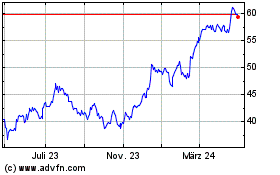Wells Fargo Reaches Settlement With Government Over Fake-Account Scandal
21 Februar 2020 - 10:40PM
Dow Jones News
By Ben Eisen
Wells Fargo & Co. will pay $3 billion to settle
investigations by the Justice Department and the Securities and
Exchange Commission over its long-running fake-account problems,
the latest chapter in an extraordinary scandal for one of the
country's largest banks.
The deal resolves civil and criminal investigations. It includes
a so-called deferred prosecution agreement, where the Justice
Department files, but doesn't immediately pursue, criminal charges.
It will eventually dismiss them if the bank satisfies the
government's requirements, including its continued cooperation with
further government investigations, over the next three years.
The scandal has severely damaged the bank's reputation as well
as its regulatory relationships. Regulators fined the bank in 2016
for creating fake and unauthorized checking and savings accounts, a
revelation that outraged lawmakers and customers.
Friday's settlement shuts the door on a major portion of the
bank's legal problems related to the fake accounts, a scandal that
has claimed two CEOs. It is a victory for Charles Scharf, an
outsider who took over as chief executive in October and was tasked
with fixing the crisis.
The bank, though, still faces major regulatory problems. Most
notably, it is under sanction by the Federal Reserve, which has
taken the unusual step of capping the bank's growth. Settling with
the Justice Department and SEC could allow the bank to focus on
persuading the Fed to lift the cap.
Regulators and prosecutors could also still take action against
individual former executives, according to people familiar with the
situation. Last month, the Office of the Comptroller of the
Currency charged eight former Wells Fargo executives over the
fake-account scandal, including a former CEO.
As part of the settlement, Wells Fargo admitted that it
"unlawfully misused customers' sensitive personal information" and
harmed some customers' credit ratings, collecting millions of
dollars of fees and interest in the process.
Wells Fargo for years enjoyed a reputation as a folksy industry
darling that catered to Main Street customers. But that reputation
was left in tatters after the sales scandal became public.
Prosecutors said the practices date to 1998, when Wells Fargo
began to rely more heavily on sales growth. It pressured employees
to sell additional products to current customers, a practice known
as cross-selling.
The heightened pressure pushed many employees to undertake
illegal practices, such as opening checking and savings accounts
without customer knowledge and making up identification numbers to
activate unauthorized debit cards. Sometimes employees forged
customer signatures to open accounts or altered customers' contact
information to prevent them from learning about unauthorized
accounts, the government said.
Regulators and prosecutors said top managers knew of these
issues in 2002. In 2004, an internal investigator called it a
"growing plague."
After the scandal erupted in 2016, the bank's top executives
faced heavy criticism for blaming lower-level employees. An
investigation by the board of directors later found that the bank's
decentralized structure allowed top executives to avoid addressing
these issues as they got bigger.
The bank has struggled to recover since then. What was once a
fast-growing lender whose profits towered above those of rivals has
become a firm with declining revenue that is leaning heavily on
cost cuts.
--Rachel Louise Ensign, Aruna Viswanatha and Dave Michaels
contributed to this article.
Write to Ben Eisen at ben.eisen@wsj.com
(END) Dow Jones Newswires
February 21, 2020 16:25 ET (21:25 GMT)
Copyright (c) 2020 Dow Jones & Company, Inc.
Wells Fargo (NYSE:WFC)
Historical Stock Chart
Von Mär 2024 bis Apr 2024

Wells Fargo (NYSE:WFC)
Historical Stock Chart
Von Apr 2023 bis Apr 2024
